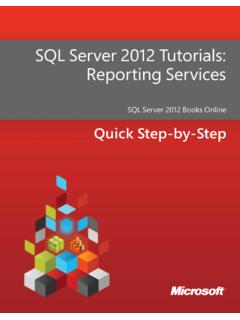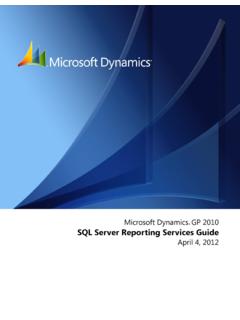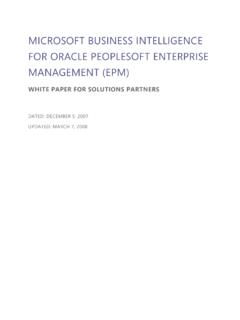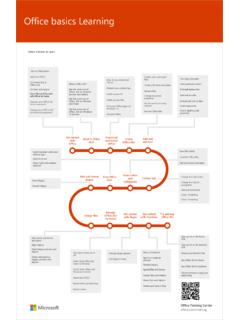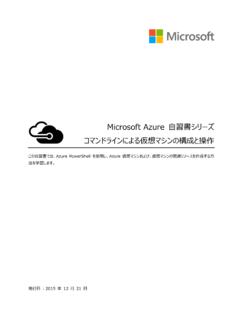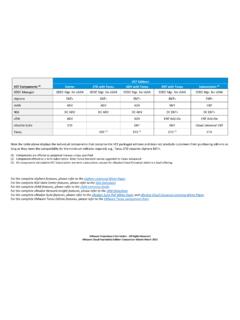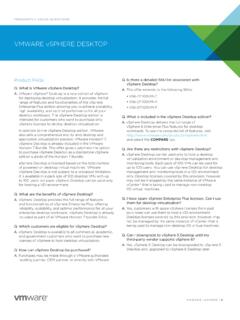Transcription of Microsoft Dynamics 365 Finance and Supply Chain …
1 1 Service description Dynamics 365 Finance and Supply Chain Management Version 10 October 2019 Service description Microsoft Dynamics 365 Finance and Supply Chain Management 2 Service description Dynamics 365 Finance and Supply Chain Management Contents Overview .. 3 Operating Model .. 5 System Configuration .. 8 Service Operations .. 10 Library .. 27 Definitions .. 30 3 Service description Dynamics 365 Finance and Supply Chain Management Dynamics 365 Finance and Supply Chain Management Service description Overview Operating model System configuration Service operations Library Definitions Overview 4 Service description Dynamics 365 Finance and Supply Chain Management Overview Microsoft Dynamics 365 Finance and Supply Chain Management is a cloud Enterprise Resource Planning (ERP) service for enterprises, built on and for Microsoft Azure.
2 It provides organizations with ERP functionality that supports their unique requirements and helps them adjust to constantly changing business environments, without the hassle of managing infrastructure. Finance and Supply Chain Management brings together a set of ERP, business intelligence, infrastructure, compute, and database services in a single offering that enables organizations to run industry-specific and operational business processes that are extendable with specific solutions from Independent Software Vendors (ISV) (see Microsoft AppSource). Organizations can match their business growth by easily adding users and business processes with a simple, transparent subscription model. Click buttons for more info. The Finance and Supply Chain Management cloud service is comprised of the components illustrated in Figure 1.
3 Figure 1: Overview of the Finance and Supply Chain Management cloud service Microsoft AppSource Licensing Guide Devices Office: Office 365, Yammer, Skype Visual Studio developer experience Finance and Supply Chain Management application Based on the Dynamics AX 2012 R3 CU9 app Finance and Operations platform Partner Apps Client Server Integration Analytics & Reporting ALM - Lifecycle Trial & signup Provisioning Deployment Diagnostics, Telemetry, & Monitoring Configuration Implementation Experience Upgrade Experience Support Experience Cross-platform (Windows, Android, iOS, OS X) Microsoft Platform (including commerce/marketplaces) 5 Service description Dynamics 365 Finance and Supply Chain Management Dynamics 365 Finance and Supply Chain Management Service description Overview Operating model System configuration Service operations Library Definitions Operating Model 6 Service description Dynamics 365 Finance and Supply Chain Management Operating model The operating model of Finance and Supply Chain Management distinguishes specific roles and responsibilities for Customer, Implementation Partner, and Microsoft throughout the lifecycle of the service.
4 Microsoft maintains the Finance and Supply Chain Management service by deploying, actively monitoring, and servicing the Customer s production tenants. This includes allocating the required system infrastructure to run the service and proactive communication to Customers about the service s health. Figure 2: Implementation roles and responsibilities Support provided by Microsoft With the support of their Implementation Partner, Customers determine the configuration of the business application logic in Finance and Supply Chain Management to match their unique business processes. Customers can extend Finance and Supply Chain Management with ISV solutions of their choice, unique customizations, or a combination of these. Customers typically choose one of the following configuration scenarios (also shown in Figure 3): Solution 1: Standard Finance and Supply Chain Management configuration (no extension) Solution 2: Finance and Supply Chain Management configuration with Customer-specific extensions Solution 3.
5 Finance and Supply Chain Management configuration with one or more ISV solutions and Customer-specific extensions Infrastructure Storage and database capacity management High availability and disaster recovery Platform security Infrastructure capacity, scale up and down Infrastructure management and deployment Data center networking, Power & Cooling Application platform Diagnostics, patches, updates, hotfixes, and updates Network management App monitoring and first line support User/data Security, identity configuration, and management Application Define and test business processes Develop and test customizations Monitoring of sandbox environments 7 Service description Dynamics 365 Finance and Supply Chain Management For any of these scenarios, the Customer defines, develops, and tests any modifications using Microsoft Dynamics Lifecycle Services (LCS) and tools.
6 Figure 3: Common configuration scenarios ISV Solution(s) Implementation Partner/ Customer Extensions Implementation Partner/ Customer Extensions Configurations: Data, process, and layout Configurations: Data, process, and layout Configurations: Data, process, and layout Finance and Operations Application Finance and Operations Application Finance and Operations Application Finance and Operations Platform Finance and Operations Platform Finance and Operations Platform Standard Dynamics 365 for Finance and Operations, Enterprise edition configuration (no customization) Dynamics 365 for Finance and Operations, Enterprise edition configuration with Customer-specific customizations Dynamics 365 for Finance and Operations, Enterprise edition configuration with one or more ISV solutions and Customer-specific customizations 8 Service description Dynamics 365 Finance and Supply Chain Management Dynamics 365 Finance and Supply Chain Management Service description Overview Operating model System configuration Service operations Library Definitions System Configuration 9 Service description Dynamics 365 Finance and Supply Chain Management System Configuration Finance and Operations scales with transaction volume and User load.
7 Each Customer implementation of Finance and Operations produces a unique solution due to the following variables: Data composition: A unique set of parameters that control behavior, layout of the organization, structure of master data (such as financial and inventory dimensions), and granularity of transaction tracking. Extension and configuration: Extension mechanisms of Finance and Supply Chain Management with code extensions, ISV solutions, and unique configurations including workflows, integrations, and report configurations. Usage patterns: A unique combination of online and batch usage combined with the ability to integrate with upstream and downstream systems for unified data flow and the ability to differentiate based on the information views used by Customers in their business processes.
8 Microsoft configures production tenants sized to handle the transaction volumes and user concurrency. Microsoft is responsible for: Proper allocation of resources of production tenants, based on the Customer s profiling information in the LCS Subscription Estimator; Continually monitoring and diagnosing service availability of production tenants; and Analyzing and troubleshooting system performance issues with Finance and Operations. To ensure that an implementation is configured for high performance, Customers must: Provide accurate usage information for the Finance and Supply Chain Management implementation through the LCS Subscription Estimator; Build and test extensions for performance and scale; and Test data configurations appropriately for performance. 10 Service description Dynamics 365 Finance and Supply Chain Management Dynamics 365 Finance and Supply Chain Management Service description Overview Operating model System configuration Service operations Library Definitions | Onboarding and implementation | Tenant and data management | Data back-up and retention | Service activity responsibilities | Service update strategy and maintenance windows | Security and administrative access | Monitoring and incident management | Business continuity with high availability and disaster recovery | Application support offerings | Service Level Agreement (SLA)
9 01 02 03 04 05 06 07 08 09 10 Service Operations 11 Service description Dynamics 365 Finance and Supply Chain Management 1 2 3 4 5 6 7 Onboarding activity windows Tenant strategy Data Service Service update Security Implementation & data back-up & activity strategy & administrative management retention responsibilities maintenance access Monitoring 8 9 Business Application & incident continuity support management with high offerings availability & disaster recovery Service Operations Service operations reflect various aspects of provisioning and use of Finance and Supply Chain Management, from onboarding and implementation to updates and monitoring. For each successful implementation of Finance and Supply Chain Management, Microsoft , the Customer, and Implementation Partners or ISVs (when applicable) have specific roles and responsibilities.
10 Onboarding and implementation Typical onboarding and implementation events and the expected responsibilities for each party are provided in Table 1. Table 1. Onboarding and implementation events Request Expected Microsoft action Expected Customer/ Implementation Partner action Initial offer purchase LCS project is created after the purchase of the offer. Go through EA or CSP onboarding process. Partner creates tenant for Customer, if applicable. Add-On purchase Grant Customer access to Add-On selected during the implementation. Not applicable. Implementation planning and analysis Provide relevant tools in LCS, such as Business Process Modeler and interoperability with Visual Studio Online. Project planning, Visual Studio Team Services, System onboarding and admin account setup.
